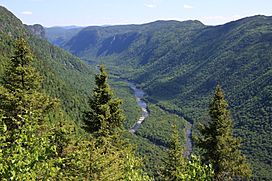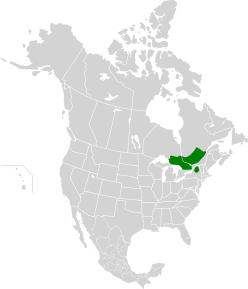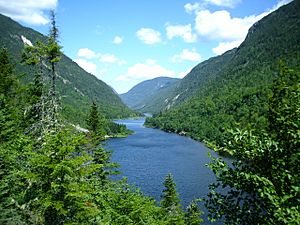Eastern forest–boreal transition facts for kids
Quick facts for kids Eastern Forest–Boreal Transition |
|
|---|---|

Jacques-Cartier National Park in Quebec
|
|
 |
|
| Ecology | |
| Realm | Nearctic |
| Biome | Temperate broadleaf and mixed forests |
| Borders | Eastern Canadian forests, Eastern Great Lakes lowland forests, Central Canadian Shield forests and Western Great Lakes forests |
| Bird species | 204 |
| Mammal species | 58 |
| Geography | |
| Countries | Canada and United States |
| States/Provinces | New York, Ontario and Quebec |
| Conservation | |
| Conservation status | Vulnerable |
| Habitat loss | 2.5% |
| Protected | 9.2% |
The eastern forest–boreal transition is a special kind of forest found mostly in eastern Canada and a small part of the United States. Think of it as a "middle ground" or "transition zone" between two very different types of forests: the Boreal Forest to the north, which has lots of cone-bearing trees (like pines and spruces), and the broadleaf forests to the south, which have trees that lose their leaves in winter (like maples and oaks). This ecoregion mixes both kinds of trees, making it a unique and important place for many plants and animals.
Contents
Where is This Forest Located?
This unique forest covers a big part of the southern Canadian Shield in Ontario and Quebec, Canada. It's found north and west of the Saint Lawrence River lowlands.
Canadian Locations
In Ontario, you can find it near places like the eastern shores of Lake Superior, Greater Sudbury, North Bay, Ontario, and Lake Nipissing. It also includes areas like Muskoka, Parry Sound, Algonquin Park, and Haliburton.
In Quebec, this forest stretches around Lake Timiskaming, the southern Laurentian Mountains, Quebec City, the Saguenay River, and Saguenay, Quebec.
United States Location
There's also a separate piece of this ecoregion in the Adirondack Mountains in upper New York State, USA.
Climate of the Region
The climate here is called a humid continental climate. This means it has warm summers and cold, snowy winters. The southern parts of the region tend to be warmer than the northern parts.
Amazing Plants of the Forest
The types of plants you find in this ecoregion can change a lot depending on the soil and how high up the land is. These mixed forests are very different from the forests further south (which are mostly deciduous) and the cooler boreal forests to the north.
Conifer Swamps
Imagine a forest that's often wet! Conifer swamps are found in areas that get flooded during certain times of the year. The trees can be very close together or spread out. The ground is often covered in soft sphagnum moss.
The main trees here are black spruce (Picea mariana) and tamarack (Larix laricina). If the soil isn't always soaked, you might also see northern white cedar (Thuja occidentalis). Around the edges of these swamps, speckled alder (Alnus incana) grows, and on higher, drier ground, you'll find red spruce (Picea rubens) and white pine (Pinus strobus).
Lowland Conifer Forests
These forests grow on flat areas, low ridges, and small hills near water. They are mostly filled with balsam fir (Abies balsamea) and red spruce. You might also spot white pine and paper birch (Betula papyrifera). The ground here is often rocky with not much other plant life.
Mixed Hardwood and Conifer Forests
These forests are a mix of trees that lose their leaves (hardwoods) and trees that stay green all year (conifers). The ground is less rocky than in the lowland conifer forests, so more plants can grow.
Common trees include red spruce, balsam fir, eastern hemlock (Tsuga canadensis), red maple (Acer rubrum), and yellow birch (Betula alleghaniensis). The plants growing under the trees are plentiful, like witchhobble (Viburnum lantanoides), honeysuckle (Lonicera spp.), and striped maple (Acer pensylvanicum). You'll also see small plants like common wood sorrel (Oxalis spp.), bunchberry (Cornus canadensis), yellow clintonia (Clintonia borealis), ferns, and mosses.
Northern Hardwood Forests
These forests grow in the richest, most fertile soils. The main trees are sugar maple (Acer saccharum), American beech (Fagus grandifolia), and yellow birch. In forests that have grown back after being cut down (called secondary forests), you might also find red spruce, white pine, white ash (Fraxinus americana), eastern hemlock, black cherry (Prunus serotina), and red maple.
Witchhobble (Viburnum alnifolium) is a common shrub growing under the trees. The ground layer has ferns and clubmosses, along with many kinds of flowers that bloom in spring.
Upper Slope Hardwood–Conifer Mixed Forests
These forests are a transition area between the northern hardwood forests and the mountain conifer forests. They are similar to the mixed hardwood and conifer forests, but without red maple. Red spruce and eastern hemlock, along with sugar maple, yellow birch, and American beech, are the main trees. You might also see scattered white pine trees.
Mountain Conifer Forests
At lower elevations in these mountain forests, red spruce and balsam fir are common. Hardwood trees like paper birch, yellow birch, and American mountain-ash (Sorbus americana) also grow among the conifers. As you go higher up the mountain, balsam fir becomes more common. Near the treeline (where trees stop growing because it's too cold), black spruce joins balsam fir in a stunted, twisted form called krummholz.
Small plants here include wood sorrel, bunchberry, yellow clintonia, and spinulose woodfern (Dryopteris carthusiana). Mosses and lichens cover exposed rocks.
Alpine Areas
At the very top of the mountains, above the treeline, you'll find alpine areas. Here, rocks are exposed and covered with lichens and mosses. Low-lying plants that are more common in the cold tundra to the north grow here. These include gold-colored deer’s hair (Trichophorum cespitosum), alpine bilberry (Vaccinium uliginosum), lapland rosebay (Rhododendron lapponicum), bearberry willow (Salix uva-ursi), mountain sandwort (Minuartia groenlandica), and alpine holygrass (Hierochloe alpina). In the Adirondacks, these special plant communities are found on 11 peaks.
Amazing Animals of the Forest
This ecoregion is home to many different animals, from tiny invertebrates to large mammals.
Birds
Old-growth forests (forests that haven't been cut down for a long time) are especially rich in wildlife. You can find many birds here, such as the American black duck (Anas rubripes), wood duck (Aix sponsa), hooded merganser (Lophodytes cucullatus), and pileated woodpecker (Dryocopus pileatus). The Lake Nipissing area is also home to the mourning dove (Zenaida macroura), northern cardinal (Cardinalis cardinalis), and wood thrush (Hylocichla mustelina).
Mammals
Many exciting mammals live in these forests. You might spot the North American cougar (Puma concolor), moose (Alces alces), American black bear, Canada lynx (Lynx canadensis), snowshoe hare (Lepus americanus), wolf (Canis lupus), coyote (Canis latrans), porcupine (Erethizon dorsatum), and white-tailed deer (Odocoileus virginianus). The eastern chipmunk (Tamias striatus) is also common, especially around Lake Nipissing.

Protecting This Special Forest
Sadly, these forests have been greatly affected over hundreds of years. People have cut down trees for timber, built roads, and developed land for farms and cities. Today, new ski resorts, logging, and mining continue to impact these areas.
Protected Areas
Luckily, many parts of this ecoregion are protected in parks and reserves. These special places help keep the forests safe for future generations.
In Quebec, some of these protected areas include:
- Papineau-Labelle Wildlife Reserve
- Mont-Tremblant National Park
- Jacques-Cartier National Park
- Hautes-Gorges-de-la-Rivière-Malbaie National Park
- La Mauricie National Park
In Ontario, you can find protected areas like:
- Algonquin Provincial Park
- Lake Superior Provincial Park
- Lady Evelyn-Smoothwater Provincial Park
- French River Provincial Park
- Killarney Provincial Park
- Several parks in Algoma District
In the United States, a very important protected area is Adirondack Park in New York. This park has some of the largest areas of original red pine and eastern white pine forests in the world. It also contains one of the biggest areas of untouched forest in the United States, called the Five Ponds Wilderness Area. These protected areas are vital for keeping this unique forest ecosystem healthy and thriving.

